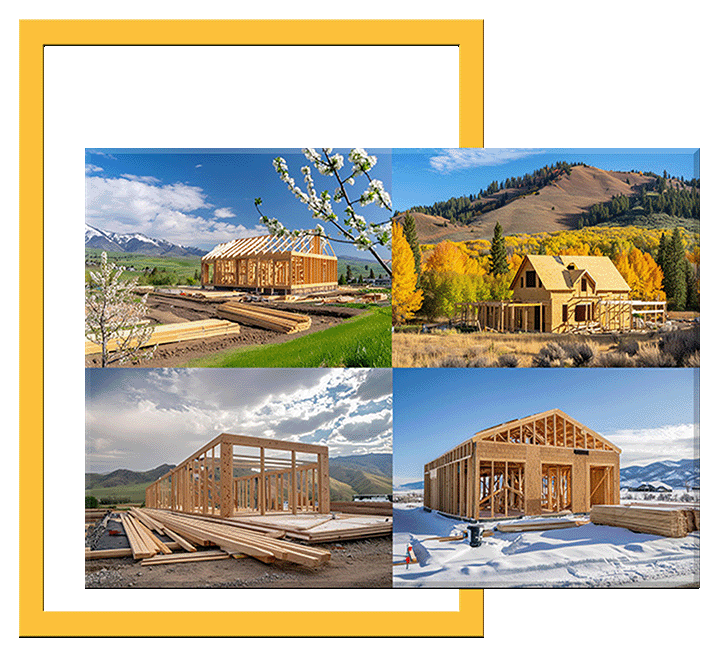
Evaluating the Seasons
1. Spring:
Spring often represents a time of renewal and is a favored season for starting construction projects. The thawing ground is more accessible for digging foundations and other groundwork. Additionally, the longer days provide more hours of daylight for construction activities. However, potential spring showers can pose delays. Initiating projects early in the season may help circumvent the worst wet conditions.
2. Summer:
Summer is a peak season for construction due to favorable weather and extended daylight hours, which can help speed up the building process. However, securing a contractor can be challenging due to its popularity, and material costs may be higher due to increased demand. Planning ahead is crucial to counter these challenges.
3. Autumn:
Many consider Autumn an ideal time because of the mild weather and the decreased demand for contractors. Material costs might also be lower as suppliers clear out inventory at year's end. Furthermore, securing permits can be faster as municipal offices are less congested. Additionally, the scenic beauty of fall can provide a stunning backdrop for your new home, enhancing both the construction experience and the final aesthetic appeal.
4. Winter:
Winter is often avoided due to cold weather complications, such as issues with concrete settings. Despite these challenges, Winter construction might benefit from reduced costs and greater contractor availability. If you begin in winter, you could move into your new home in the more pleasant spring or early summer months.
Considering Geographic Location
#1. Northern Climates:
<< Late Spring Start:
The northern regions are characterized by cold, harsh winters, so beginning construction in late spring is generally advisable. This allows the ground to thaw completely, ensuring that the soil is suitable for excavation and foundation work. Additionally, beginning in late spring ensures that most construction can occur during warmer months, minimizing the risks associated with freezing temperatures, such as poor concrete curing and increased heating costs.

<< Maximizing Daylight:
Northern regions also experience significant variations in daylight hours throughout the year. By scheduling the bulk of construction in the summer, you can take advantage of longer daylight hours, improving worker safety and productivity.
#2. Southern Climates:
<< Fall Construction Start:
n contrast, southern climates often experience extremely hot summers, which can slow down the construction process due to heat-related work stoppages and increase the risk of heat exhaustion among workers. Starting construction in the fall can help avoid the peak summer temperatures, leading to a more comfortable and efficient work environment.
<< Weather Considerations:
Additionally, fall often brings more stable weather patterns in southern regions, with less risk of severe storms or hurricanes that can occur in summer and spring, thus reducing potential delays and damage.
#3. Tropical and Monsoon-Affected Areas
<< Avoiding the Wet Season:
Planning construction around the wet season is crucial in areas affected by monsoons or tropical climates. Heavy rains can cause flooding and washouts, delaying construction and damaging materials and partially completed structures. Scheduling construction for the dry season can mitigate these risks.
#4. Mountainous and Coastal Areas
<< Special Environmental Considerations:
Areas with unique geographical features, such as mountainous or coastal regions, require special planning. For instance, mountainous areas might have limited access during winter due to snow, and the coastal regions might need to consider tide levels and storm surges, particularly if starting construction near a coastline.
#5. Consider Local Regulations and Migration Patterns
<< Regulatory Timing:
Some regions might have specific times of the year when construction is restricted due to local ordinances or environmental regulations, such as noise restrictions or protections for migrating wildlife.
<< Community Impact:
It's also wise to consider the local community's schedule—avoiding construction during major local events or tourist seasons can minimize disruptions and foster community support for the project.
Environmental Impacts
#1. Reducing Soil Erosion and Runoff:
<< Dry Season Benefits:
Conducting earth-moving activities such as digging foundations and landscaping during dry seasons can significantly reduce the risk of soil erosion. Without heavy rains, the disturbed soil is less likely to be washed away, which helps maintain soil health and prevents sediment from polluting nearby waterways. Additionally, less runoff reduces the risk of water pollution and the negative impact on aquatic life.

<< Vegetation Preservation:
Planning major land alterations when vegetation is dormant (typically in late fall or winter in many climates) minimizes damage to the existing flora. This timing allows for a natural recovery as vegetation returns into growth season, which can help stabilize the soil and integrate the new construction more harmoniously with the natural environment.
#2. Enhancing Air Quality:
<< Avoiding High Pollution Periods:
In many urban areas, air quality can deteriorate during certain times of the year due to increased heating use in winter or smog in summer. By scheduling construction activities during periods of better air quality, you can help reduce the overall air pollution levels, benefiting workers on site and the broader community.
#3. Optimizing Resource Use:
<< Seasonal Material Sourcing:
Some materials can be sourced more sustainably during specific seasons. For example, when sap runs are low, harvesting wood during late winter or early spring can minimize the impact on tree health and the surrounding forest ecosystem.
<< Energy Efficiency:
Building during milder weather conditions can also reduce the energy needed for heating or cooling the site, which not only lowers emissions but can also reduce construction costs.
#4. Wildlife Considerations:
<< Scheduling Around Wildlife Cycles:
Understanding local wildlife breeding and migration cycles is crucial. Avoiding construction during critical periods for local wildlife, such as nesting or migration seasons, can prevent disruptions and long-term damage to biodiversity.
#5. Water Usage:
<< Managing Water Demand:
Construction requires significant water use, particularly for making concrete and controlling dust. Planning construction during seasons when water availability is higher, and demand from other sectors (like agriculture) is lower can ease the strain on local water resources and help maintain the water balance in the ecosystem.
Economic Factors
<< Interest Rates:
Favorable interest rates make loans more affordable, potentially extending your budget. Lower interest rates can significantly decrease the overall cost of borrowing, allowing you to allocate more funds towards higher quality materials or additional features.
<< Market Trends:
During a market downturn, labor and material prices may be reduced. Economic recessions often lead to decreased demand in the housing market, prompting suppliers and contractors to lower their prices to attract business. This can be an opportune time to secure contracts at a reduced rate.
<< Availability of Resources:
Be wary of possible material shortages, which can delay the project despite high labor availability during economic slumps. It's important to monitor supply chain issues affecting the availability of essential construction materials like lumber, steel, or concrete.

Additional Economic Considerations
<< Inflation:
Inflation can significantly impact the cost of construction materials and labor over time. Building during a period of low inflation may help control costs more effectively. Conversely, if inflation is expected to rise, it might be wise to start construction earlier to avoid future cost increases.
<< Government Incentives:
Occasionally, government programs or incentives to stimulate construction or home ownership can provide opportunities for savings. These might include tax breaks, subsidies, or low-interest loans for new home construction, particularly for energy-efficient or green buildings.
<< Local Economic Conditions:
he local economic health can also influence construction costs. For instance, in areas experiencing economic growth, higher demand for contractors and materials may drive up prices. Understanding the local economic climate can help in planning the best time to build.
<< Currency Fluctuations:
For projects that rely on imported materials or foreign labor, currency exchange rates can notably impact costs. Monitoring these rates and planning accordingly can help in budget management.
<< Real Estate Market:
The state of the real estate market in your area can also influence the decision of when to build. If the market is saturated with homes, waiting for a more favorable time when fewer listings might maximize your investment when it comes time to sell.
Personal Timeline
<< Financial Readiness:
Building a home requires solid financial grounding and a contingency fund to cover unexpected costs. Ensuring that you have adequate savings and a secure financial plan can prevent potential financial strain during construction.
<< Family Considerations:
Consider the impact of family events, such as pregnancies or significant life changes, on your construction plans. For instance, the needs of a growing family or caring for elderly family members can affect the design and timing of your new home.
<< Career Stability:
A stable career with minimal travel can make supervising your home build less stressful. Undertaking such a significant project is beneficial when you can commit the necessary time to oversee the process and make timely decisions.
Additional Personal Considerations
<< Lifestyle Changes:
Anticipate any significant lifestyle changes that might occur during the construction phase. For example, transitioning to working from home permanently may require incorporating a home office into the design, affecting both the timeline and budget.
<< Educational Commitments:
If you or your family are involved in academic programs, consider how school schedules and commitments might impact your availability to manage the home-building process.
<< Health Considerations:
Health conditions that might affect your ability to engage with the construction process or require specific home accommodations should also be considered.
<< Retirement Planning:
If you are approaching retirement, you might prioritize accessibility features and a design that will allow you to age in place comfortably.
<< Long-term Commitments:
Assess other long-term commitments, such as ongoing community or professional projects, that might impact your ability to dedicate time and resources to the home-building process.
<< Seasonal and Holiday Considerations:
Planning construction around your family's significant dates, holidays, and vacation plans can ensure that these events are not disrupted and that stress is minimized during these times.
Navigating Changes During Construction
Adapting to Weather Variabilities:

<< Prompt Drying:
Using industrial fans and dehumidifiers to accelerate the drying process, ensure the structure is completely dry before proceeding with additional construction, such as insulation or drywall installation.
<< Waterproofing Measures:
Apply waterproofing treatments to surfaces that are frequently exposed to moisture. This includes using water-resistant materials like treated wood for framing and moisture barrier products on foundation walls.
<< Mold Prevention:
After drying exposed surfaces thoroughly, treat them with anti-mold sprays. This is especially important in areas that are hard to access once construction progresses.
<< Regular Inspections:
Conduct frequent inspections during and after wet conditions to identify and remediate any water damage early on. This helps to avoid more serious issues as construction continues.
Responding to Material Cost Fluctuations:
Flexible Planning and Effective Communication:
Preparedness for the Unexpected:
Change Orders and Documentation:
<< Change Orders:
Throughout the construction process, any deviations from the original plan, whether due to weather, cost fluctuations, or other unforeseen factors, should be documented through change orders. This formalizes any alterations in the scope, materials, costs, or schedule.
<< Document Everything:
Maintaining detailed records of all decisions, changes, and communications is essential. This documentation should include dates, descriptions of the issues, steps taken to resolve them, and all communications between contractors, subcontractors, and clients. Effective record-keeping supports transparency, aids in dispute resolution, and is crucial for insurance claims and audits.
Conclusion
Partner with Coats Construction Concepts
References
- Vergo. (2024). “Building from the Ground Up: Foundation Best Practices.” by Jordan Terry.
- Miller & Associates. (Q1 2024). “Miller releases construction market review of Q1 2024.” Market Review.
- Unique Paving Materials Corp. (2018). “Pouring Concrete in Cold Weather vs. Pouring Concrete in Hot Weather.” by Becky Dunlavey.
- Giatec. (2024). “Important Considerations of Cold Weather Concreting.” by Methrtash Soltani.
- Premier Design Custom Homes, LLC. (2020). “Deciding When to Build a House Raises Many Questions.” by Jerry.
- Home Cost. (2024). “Impact of Seasonal Changes on Home Construction Costs.”
- Brownstein. (2021). “Managing the Impacts of Material Price Fluctuations on Construction Projects.” by Jonathan Pray, Kevin Walsh.
- 10X Builders. (2023). “When is a Good Time to Build a Custom Home.” by AJ Moore.
- AcqNotes. (2023). “Building Success Amidst Uncertainty: Navigating the Complexities of Firm-Fixed-Price Contracts in Construction.” by Berton Manning.
- myComply. (2022). “Change Orders in Construction: The Essential Guide” by Brock Andony.
- Buildertrends. (2023). “Construction Change Order Best Practices, Examples and More.” By Sean Robinson.
- WorkYard. (2023.) “Construction Change Management: Everything You Need to Know.” By Heather.
